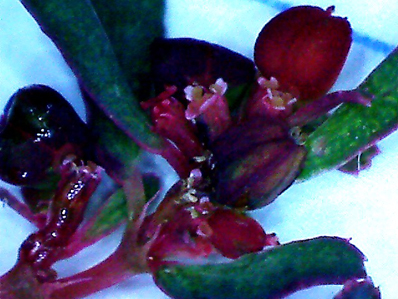
Location
On convento wall (N35D32'59.418 X W105D41'20.819)
Flowers first observed: 9/22/17
Plant w/Flowers
 |
 |
Plant w/Flowers |
50X Flowers |
Distribution
"Dry sandy or alluvial soils[43, 235]. N. America - British Columbia to Michigan and Wisconsin, south to California, Texas and Mexico." (Plants for a Future)
"Euphorbia serpyllifolia is a ANNUAL growing to 0.3 m (1ft). The flowers are monoecious (individual flowers are either male or female, but both sexes can be found on the same plant) and are pollinated by Insects.Suitable for: light (sandy) and medium (loamy) soils and prefers well-drained soil. Suitable pH: acid, neutral and basic (alkaline) soils. It cannot grow in the shade. It prefers dry or moist soil." (Plants for a Future)
Description
"Uncommon annual forb, +/- ascending, overall height 10 cm; herbage glabrous; petaloid appendages present; glands oval, dull yellow" (SW Biodiversity)
- "Leaf type
- the leaves are simple (i.e., lobed or unlobed but not separated into leaflets)
- Leaf arrangement
- opposite: there are two leaves per node along the stem
- Leaf blade edges
- the edge of the leaf blade has teeth
- Flower symmetry
-
- NA
- there are two or more ways to evenly divide the flower (the flower is radially symmetrical)
- Number of sepals, petals or tepals
- there are no petals, sepals, or tepals in the flower, or they are not clearly present
- Fruit type (general)
-
- the fruit is dry and splits open when ripe
- the fruit is dry but does not split open when ripe" (Go Botany)
Ethnobotanical Uses
Food:
"Edible Parts: Leaves; Root.
Edible Uses: Drink.
Root - cooked. They are chewed (by women!) and then mixed with corn meal to sweeten it[161]. One report says that the women would keep the root in their mouths for two days, only taking it out when taking refreshments or sleeping. At the end of that time as much cornmeal as possible was placed in the mouth and held there, without chewing, until the build-up of saliva forced ejection of the mass[257]. (Saliva contains certain enzymes that convert starches to sugars and so it will sweeten corn meal on its own[K].) The chewed root acts like a yeast preparation and has been used in making cakes[257]. The root can be dried for later use[257]. The root has been fermented to make an intoxicating drink[257]. The leaves are used for chewing[161, 177]. They have a pleasant taste[257]. All these uses should be viewed with some caution, see the notes above on toxicity." (Plants for a Future)
"The sap contains a latex which is toxic on ingestion and highly irritant externally, causing photosensitive skin reactions and severe inflammation, especially on contact with eyes or open cuts. The toxicity can remain high even in dried plant material[200]. Prolonged and regular contact with the sap is inadvisable because of its carcinogenic nature[214]." (Plants for a Future)